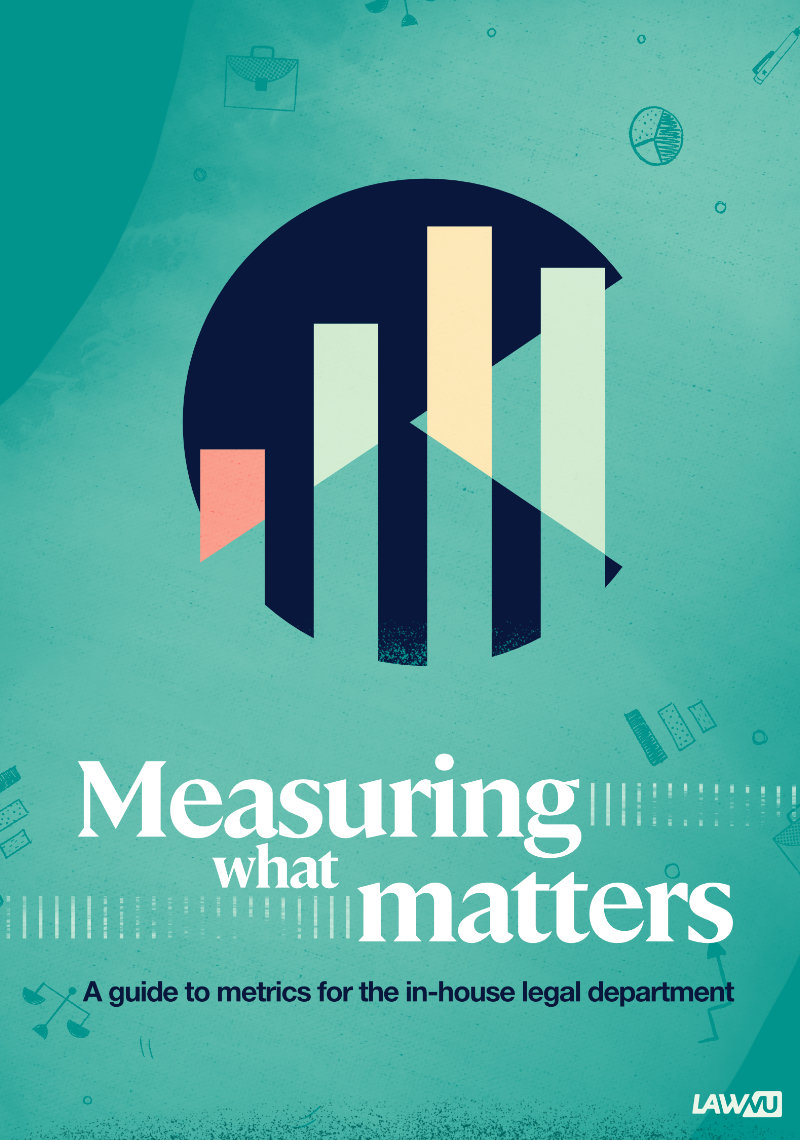Experience, intuition, and qualitative information play an essential role in a legal team’s toolkit, but there’s also a place for decisions based on fact – that is, the data.
Where other departments within the business are already using data to support decisions around performance, predicting future needs, justifying expenditure, and reporting risk, legal seems to be trailing behind.
Yet the data is all there, it’s just a matter of capturing the underlying activity that produces the data in a way that also improves productivity while structuring it, surfacing it, and using it in a meaningful way.
Using data to inform decisions means working from a position of knowledge, where supporting evidence is presented to build a greater understanding of the situation and reduce the uncertainty during the decision-making process.
In this whitepaper, we’ll take you through the importance of using metrics for decision making, how to align metrics with your organization’s strategy, key metrics to use, and some steps to take when you’re ready to start using metrics for analyzing and reporting on your legal department’s activities.
How mature are your metrics
Lawyers are not necessarily trained in data and analytics. However, they do understand the need to back up decisions with evidence.
It’s time for the legal department to join its non-legal colleagues in leveraging data and analytics.
When looking at legal through the lens of predictive (or prescriptive) analytics maturity, in-house legal departments are generally working from a place of hindsight. That is, looking back at what has previously happened. To facilitate this, data can sometimes be gathered manually and used to generate static reports. It’s the same place other departments were decades ago.
The next step is insight, where real-time data sets are available for use in strategic business decisions. This is the phase that most legal teams are working towards currently, albeit in a somewhat haphazard way. Our mission in this whitepaper is to convince you that this stage is achievable, that there is a clear “playbook” for reaching this, and that from a data perspective this is just the beginning.
Beyond that is the foresight stage, which essentially means that you have enough historical data, that you know based on the current state what will most likely happen next. By definition, in an industry such as legal that has very little in the way of structured datasets, this will take time.
The ultimate goal is the prescriptive phase/amplified intelligence and automation phase. This is where your data can not only see the future but bend or focus it (think “Minority report” but for legal teams), in order to proactively contribute to the important strategic decisions being made within your organization.
Imagine being a CFO, looking at a set of numbers on a page, and trying to figure out what the story is and where savings can be made. For the legal department, the numbers just show the costs. What’s missing is the other side of the conversation, the benefits and value of the legal team, what it’s working on, and how its work contributes, strategically, to the business as a whole.
The only way to combat this is to start using data and metrics and change the way legal teams show value to the rest of the business.
The importance of context
A metric is a data point in contet
But what do we mean when we talk about “data” and “metrics” and how are the terms distinct to “measurements”?
PwC defines a measurement as a data point at a single point in time. A measurement doesn’t need to be 100% accurate or eliminate all uncertainty; it simply reduces uncertainty based on one or more observations.
A metric is a data point in context.
Metrics express information at one point in time relative to another point in time, or data about one organization relative to another organization. Metrics are more useful than measurements because they provide context to support decisions.
This is where it’s clear to see the benefits of having structured data collected in the one place where it can be surfaced and used for metrics, bringing value to the numbers.
Why do metrics matter?
Organizations are adapting and growing through the use of new and emerging technologies, with the benefits being welcomed across departments from relationship management and marketing, through to manufacturing and delivery.
Yet the in-house legal department is often left out, working away with piecemeal and legacy technology that’s struggling to keep up with the times.
Innovative technology stalls at the door of the in-house legal department, due to three key reasons:
- in-house lawyers often work on highly material, strategic matters, and are less required to justify their resources;
- the legal department’s relatively small size often triggers a managerial assumption that tech investments in the division would be better spent in a larger department;
- there is a lingering belief legal work is of such an exceptional, specialist nature it cannot be quantified – or even if it could be properly measured, there would be nothing substantial to gain from doing so.
However, now more so than ever, where organizational spend is being tightened across the board, the in-house legal department needs objective metrics to quantify and defend its output, as well as finding ways to operate even more strategically.
Quantifying legal performance with data assists with:
- showing a legal department’s value;
- measuring KPIs and track performance;
- controlling legal spending;
- analyzing trends.
Metrics deliver the knowledge to show how the in-house legal department contributes to the business.
Making better decisions
Ultimately, organizations thrive when great decisions are made.
“Business Intelligence” is one of CLOC’s Core 12 Competencies, and focuses on making better decisions through the use of data. CLOC says the current reality is that in-house departments make minimal use of data and metrics, often struggling to access or identify the right data, and/or lacking the culture to make consistent use of analytics. The alternative is an organization that is managed and guided through data, not intuition, and uncovers hidden trends, new efficiencies, and focuses on the teams clear and measurable outcomes that make a difference to the business, such as:
- determining the right data to collect and monitor;
- designing and rolling out metrics and dashboards;
- creating data lakes and implementing advanced analytics;
- spotting patterns and identifying hidden opportunities;
- improving both short- and long-term outcomes through data analysis.
As part of its Metrics Initiative, CLOC developed a core set of metrics to measure performance based on readily accessible data. Using the supplied formulas, metrics are calculated in a basic tool like Excel or Google Sheets, or for more advanced evaluations using even more data, using a third-party solution to consolidate and analyze data.
Many decisions made in the legal department around resourcing, legal spend, training, client engagement, and risk can have astronomic legal, operational and reputational consequences and benefits, which means that although instinct and experience are crucial to good business, there’s still a lot to be gained by strengthening those decisions with the appropriate data, metrics and reporting.
The value of metrics is that they show the true value of legal to a business.
Strategic moves
From data points to discussion points
The magic of metrics begins when the findings are analyzed, reported on, and used to inform the decision-making process. Yet, metrics are only as good as the data collected and are only useful if they support the strategic direction of the organization – otherwise, they’re just another set of numbers.
Therefore, before embarking on a metrics project, it’s essential to assess the key strategic decisions that need to be made, and identify the metrics to support them.
For example:
Legal work prioritization and resourcing
One of the most important choices the in-house legal department needs to make is how to make use of its limited resources in order to function effectively and efficiently. Understanding the type and volumes of work coming to the legal team is crucial in determining whether the right skillsets are currently in-house and what future resourcing needs are likely to be. A clear framework where the work and responsibility of the department are clearly defined serves both the legal team and the wider organization.
Reducing external legal spend
Deciding how the work that is part of the legal department’s function sits within the legal department or is outsourced, is another important consideration.
While there’s likely to always be a need to contract out to external legal firms and non-legal providers to assess in-house legal departments, there are strategic decisions around to what extent legal departments should outsource specific types of legal and non-legal work, and what type of work should be outsourced.
Decisions of the division of work also impact how many full-time equivalent lawyers and non-lawyers the legal department needs to have, and how many staff members are specialists or generalists in their field.
Automating and streamlining manual processes
Dividing the workload is another key decision related to the division of a legal department’s manual work. Often this discussion includes a need to explore how technology and the automation of tasks can benefit a team, such as bypassing human error and ensuring all key personal data and highly sensitive and protected data is referred to accurately, as well as adequately protected in all contracts.
Risk management
Should the legal department’s approach to risk be more aligned with that of the organization’s? A formal process that outlines both how and when the legal department reviews risk (including its interface with any separate risk team or enterprise risk policy) should be considered to ensure that risk management is aligned with the organization’s risk appetite.
Aligning strategic goals and objectives between the legal department and the organization as a whole, and recognizing where the differences exist, brings the opportunity to have everyone working together, and in the same direction.
Showcasing value
Measuring and showcasing the value in-house legal teams provide to the business in alignment to better business outcomes is another example of a key strategic decision that metrics can support.
For example, metrics are required to measure contract value unlocked or risk controlled by the legal team, or even the impact of new initiatives implemented to reduce bottlenecks and turnaround times.

“We can see the volume of work that’s coming in. I can identify how much of that work’s being done
Start with your system of record
The generation of data is a by-product of day-to-day life in the in-house legal department. Yet while it exists, it’s only able to be located and utilized if it’s captured in a structured format.
The message for the legal industry is that, from a legal-tech perspective, you need to start building your system of record so you can start capturing data in the right ways. The best way to do this is by adopting a legal workspace approach, where everything that a legal team works on and utilizes day-to-day and with the wider business – from matters to contracts, to spend management and knowledge and documents, is all in one place, as one source of truth or system of record.
Your data will get richer as you and your colleagues conduct more of your work in the workspace. In no time at all, you’ll be using metrics and creating reports that offer insights into the activities of your department.
The top ten metrics
Provided that data is captured in a system of record and able to be easily surfaced, the next step is to decide which metrics need to be selected in order to provide the most valuable analytics and reports.
Some of the most popular metrics are listed below, and they’re a great starting place to start thinking about what your legal department needs to be reporting on.
Team workload and visibility
1. The types and volume of work
Knowing the types of work that the legal team is working on is one way to gain visibility and understanding over how the legal team spends their time. By looking at the types of matters and contracts that come into legal, it also helps to understand where the legal team’s work is being driven from and to showcase how the legal team is supporting the wider business.
Combining the types of work with volume of work over time is useful to:
- identify trends that will help to decide whether there’s a need for additional resources; and
- optimize the distribution of work to better manage team capacity.
2. Key dates and tasks
Surfacing important dates, such as contract expiry dates, allows the legal team to prioritize work and be proactive with tasks that are in need of attention, ultimately improving efficiency and control of risk.
3. Turnaround/cycle times
Another useful key metric or data point is the cycle-time of matters. By looking at how long a matter type is open, the legal department can understand which types of matters are typically open for longer or shorter periods of time.
This allows you to identify outliers early and demonstrate whether cycle times have increased or decreased – showcasing an improvement in efficiency to the wider business.
4. Volume vs strategic value in work
The highest volume, lowest strategic value work is typically the category of work most suited for automation solutions.
By rating each matter or piece of work for its strategic value, you can then compare this against volume and understand what you should be trying to automate, or conversely, spend more valuable time on.
Business engagement and value
5. Self-service vs supported work
Tools like LawVu can offer self-service features such as contract automation or knowledge base ‘how-to’ articles. Tracking the use of these tools by the wider business and comparing that with how much legal advice/support is provided by the legal team can help you demonstrate the value that legal is providing to the wider business as well as determine where operational efficiencies can be driven in the future.
It's also helpful to see the differences between the use of
self-service tools such as wizards and templates that allow the business to create their own contracts and upload contracts to the CLM for review. These insights can help identify which contract types could possibly become templated, enabling the business to better self-serve some of their legal needs.
6. Risk vs value
With contract management systems such as LawVu, you can grade each contract or matter according to its value to the organization and its objective risk.
At the end of your reporting period, you can then surface a beautiful picture of the overall value of contracts or deals that the legal team has unlocked and the risk it has managed. Data like this is a great way to showcase the value that the legal team is providing to the wider business.
7. Platform usage
Metrics uncovering platform use are often overlooked. However, they can help identify how your business colleagues are engaging with your legal technology and therefore the legal team.
Beyond monitoring user activity, the legal team has a wealth of knowledge. Knowing which articles or guides the business uses the most is a great way to understand what’s working and what’s not. It also helps to decide or keep track of popular articles that may need to be updated.
Spend management
8. Budget vs spend
Tracking your budgets for both internal matters and outsourced legal work (on a per firm basis) against your actual spend is important for a number of reasons. The main reasons being that you can more accurately estimate budgets in the next period and also keep on top of the firms that are not keeping to budget, enabling more effective spend management overall.
9. External legal spend by matter type, department, team, or region
Measuring legal spend on outsourced matter types can be incredibly valuable. For example, it can help you understand whether there is a particular practice area in which there is a significant amount of legal spend, and consider whether it would be more cost-effective to bring this work in-house.
You may also discover that you’re spending a huge amount of budget on outsourcing work in a particular practice area, and that’s because you simply lack the capability in-house rather than the capacity. Findings like this could help you decide whether to increase budgets on training, onboard specific expertise, or continue to engage with outside counsel.
10. Self-service vs supported work
This metric, combined with the metrics above, quickly paints a solid picture for a leader in legal operations or a General Counsel around the type and volumes of work being outsourced in comparison to the work completed in-house.
Beyond volumes, if you can easily compare and report on details of matters being handled internally and externally – such as type, complexity, department, and risk level, you can make better decisions about resourcing, staffing and budgeting with internal and external partners
Making impactful decisions with LawVu
LawVu insights and reporting capabilities is the data and analytics tool for in-house legal departments. It surfaces data from across the whole LawVu workspace (matter, contract, spend, and admin), providing deeper understanding of in-house performance, external counsel performance, spend management, and platform usage. This in turn enables:

